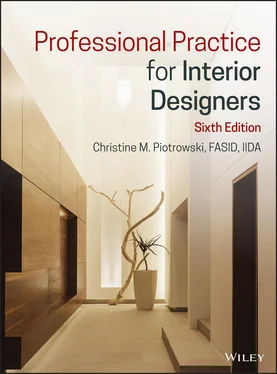Christine M. Piotrowski - Professional Practice for Interior Designers
Здесь есть возможность читать онлайн «Christine M. Piotrowski - Professional Practice for Interior Designers» — ознакомительный отрывок электронной книги совершенно бесплатно, а после прочтения отрывка купить полную версию. В некоторых случаях можно слушать аудио, скачать через торрент в формате fb2 и присутствует краткое содержание. Жанр: unrecognised, на английском языке. Описание произведения, (предисловие) а так же отзывы посетителей доступны на портале библиотеки ЛибКат.
- Название:Professional Practice for Interior Designers
- Автор:
- Жанр:
- Год:неизвестен
- ISBN:нет данных
- Рейтинг книги:4 / 5. Голосов: 1
-
Избранное:Добавить в избранное
- Отзывы:
-
Ваша оценка:
- 80
- 1
- 2
- 3
- 4
- 5
Professional Practice for Interior Designers: краткое содержание, описание и аннотация
Предлагаем к чтению аннотацию, описание, краткое содержание или предисловие (зависит от того, что написал сам автор книги «Professional Practice for Interior Designers»). Если вы не нашли необходимую информацию о книге — напишите в комментариях, мы постараемся отыскать её.
Professional Practice for Interior Designers
Professional Practice for Interior Designers — читать онлайн ознакомительный отрывок
Ниже представлен текст книги, разбитый по страницам. Система сохранения места последней прочитанной страницы, позволяет с удобством читать онлайн бесплатно книгу «Professional Practice for Interior Designers», без необходимости каждый раз заново искать на чём Вы остановились. Поставьте закладку, и сможете в любой момент перейти на страницу, на которой закончили чтение.
Интервал:
Закладка:
The CIDQ was formalized in 1970 joining together credentialing bodies throughout North America. After several years of discussions between CIDQ and the associations, the NCIDQ was organized in 1972 and became an independent corporation in 1974. Its purpose was to maintain standards of practice and develop a means of testing competence for legal qualifications for licensing and title registration. This examination is fully recognized by the major professional associations in the United States and Canada, as well as the IDEC, IDCEC, and the CIDA. The NCIDQ examination is also the primary examination in those U.S. states and Canadian provinces that have licensing, certification, or other registration statutes. Competency requirements in other nations are controlled by each country. Someone who wishes to work internationally must be sure they will be able to work legally.
CIDQ is not a professional association like American Society of Interior Designers (ASID) or International Interior Design Association (IIDA). Individual membership does not exist. The CIDQ organization brings together representatives from state and provincial boards that regulate interior design in their jurisdictions. These representatives and their volunteers work to develop and administer the NCIDQ examination.
Detailed information about qualification, examination application, and information concerning the basic contents of the exam are easily obtained by all from the CIDQ Web site www.cidq.org. A brief overview of the exam is provided here.
The NCIDQ Examination Overview
Eligibility requirements involve a combination of years of education in interior design and a period of work experience. The reader should review CIDQ's current requirements via the Web site or telephone discussions.
The exam itself is in three parts: two parts are computer‐graded multiple‐choice tests focused on application of knowledge and skills, not simply recall of facts. The third part is a practicum problem and requires that candidates produce design solutions.
The examination tests all areas of design practice either through the multiple‐choice questions or the practicum requirements. Topics that are generally included are: codes, building systems, design application, project coordination, life safety, professional practice, and other issues standard to the interior design profession.
An individual who passes all the sections of the examination has thus earned a certificate. Certificate holders are not allowed to place the NCIDQ acronym on their business cards or other marketing materials without also including their certificate number, for example, Jim Jones, NCIDQ Certificate number 12345. Placing something like “Jim Jones, NCIDQ” on a business card is an incorrect use.
Contact CIDQ for information on study methods, resource lists, sample tests, and other tips on preparing to take the NCIDQ examination. Although no formal study groups are available from the professional associations, candidates might find informal study groups locally through associations.
Other Professional Certifications
There are other professional certifications that might be of interest to interior designers. Complete information regarding the qualification and application procedures for these certifications can be obtained from these organizations' national offices or Web sites. Other certification programs for builders and contractors may be appropriate for the interior designer based on education, experience, and business/professional goals.
American Academy of Healthcare Interior Designers (AAHID). This professional certification is specifically for those designers who have become specialized in healthcare interior design. Use of the AAHID appellation means the individual has achieved specific experience, passed the NCIDQ examination, and provided other evidence of his or her interior design experience in healthcare facilities. Contact www.AAHID.orgfor complete qualifications and testing information.
Certified Aging‐in‐Place Specialist (CAPS). Administered through the National Association of Home Builders (NAHB), for individuals who have achieved additional business, technical, and customer service skills necessary for working in the aging‐in‐place segment of the industry. Contact www.nhab.orgfor qualifications and testing information.
Certified Kitchen Designer (CKD) or Certified Bathroom Designer (CBD). Administered through the National Kitchen and Bath Association (NKBA), for individuals who have demonstrated extensive experience and specialized education in the design of kitchens and bathrooms. Contact www.nkba.orgfor qualifications and testing information.
Leadership in Energy and Environmental Design (LEED ®). LEED ®certifications are administered by the U.S. Green Building Council for those designers interested in and dedicated to sustainable design. Several certifications are available for interior designers, based on specialty: LEED‐AP ID+C, for interior design of commercial spaces; LEED‐AP BD+C, for building design and construction; LEED AP Homes, for designers involved in the design of green homes; and LEED Green Associate, for those interested in green building practices but engaged in a nontechnical field. Other LEED‐AP certifications exist for areas less related to interiors. Contact www.usgbc.org.
Lighting Certified professional (LC). This certification is granted by the National Council on Qualifications for the Lighting Professions (NCQLP). Indicates a specific and high level of expertise and knowledge concerning lighting techniques, principles, design, and compliance. Contact www.ncqlp.orgfor qualifications and testing information.
LICENSING AND REGISTRATION
Regardless of the profession, professionals are predominately licensed or registered by a state or provincial regulatory body. In the case of interior design, licensing or registration is done to recognize the minimum standards and qualifications of those who wish to engage in the interior design profession within a jurisdiction. It is important to understand that although local design practitioners spearhead licensing and registration efforts, licensing and registration standards are established by state and provincial legislation.
Licensing and registration efforts have been a part of the profession's activities since 1951, when the Southern California chapter of AID attempted to get a bill passed in the state legislature. Professionals, with the assistance of local licensing coalitions, continue to pursue licensing legislation or regulation on a state‐by‐state basis. Professional associations provide coalitions with information, but do not advocate legislation that would limit who may practice in the interior design industry.
Several terms relating to this topic are used frequently concerning the interior design profession. Here we define them and then discuss them in detail. The distinctions are important.
Licensing: most frequently associated with a state or province whose legislation defines who may practice interior design—much like a state law defines who may practice medicine.
Practice acts are a type of licensing in which guidelines are established concerning what an individual can or cannot do in the practice of a profession in a particular state.
Title acts are concerned with limiting the use of certain professional titles, such as interior designer, registered interior designer, or certified interior designer.
Registration or certification is most frequently associated with legislation that defines who may use a certain title, such as registered interior designer.
Self‐certification: similar to a title act, but use of the title is controlled by an independent organization; the jurisdiction has very little control. California is the only state with self‐certification.
Читать дальшеИнтервал:
Закладка:
Похожие книги на «Professional Practice for Interior Designers»
Представляем Вашему вниманию похожие книги на «Professional Practice for Interior Designers» списком для выбора. Мы отобрали схожую по названию и смыслу литературу в надежде предоставить читателям больше вариантов отыскать новые, интересные, ещё непрочитанные произведения.
Обсуждение, отзывы о книге «Professional Practice for Interior Designers» и просто собственные мнения читателей. Оставьте ваши комментарии, напишите, что Вы думаете о произведении, его смысле или главных героях. Укажите что конкретно понравилось, а что нет, и почему Вы так считаете.












